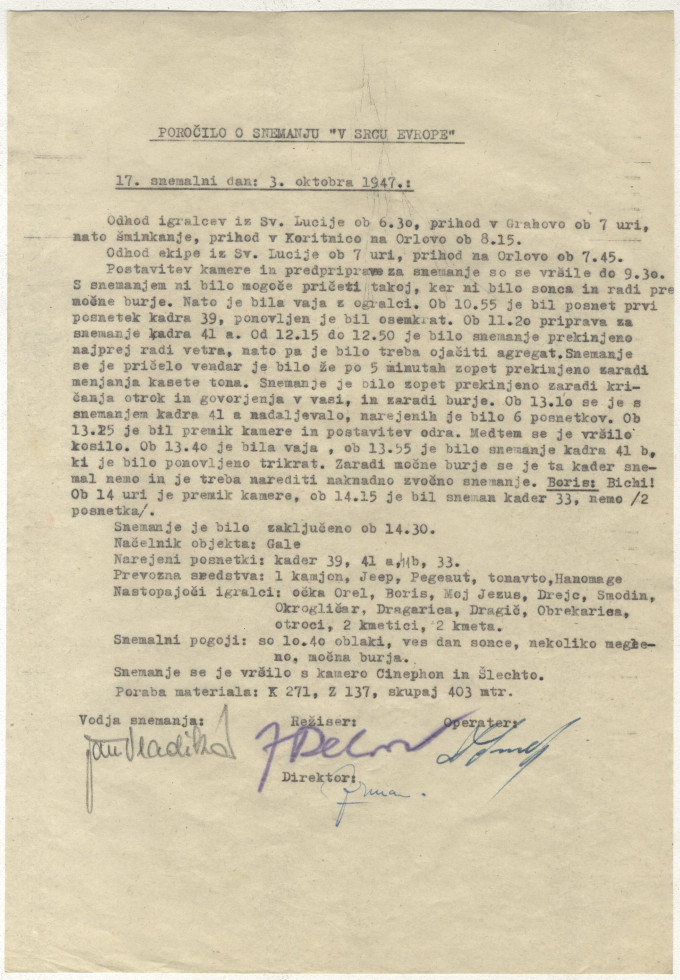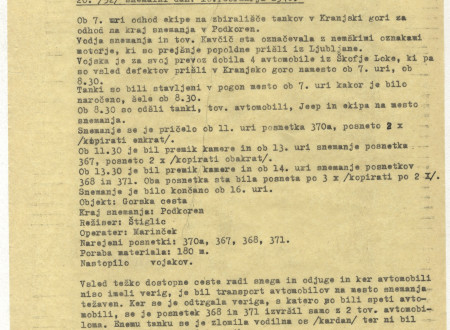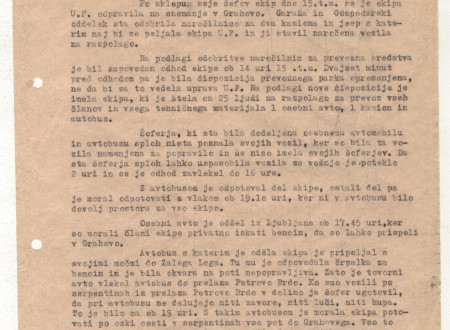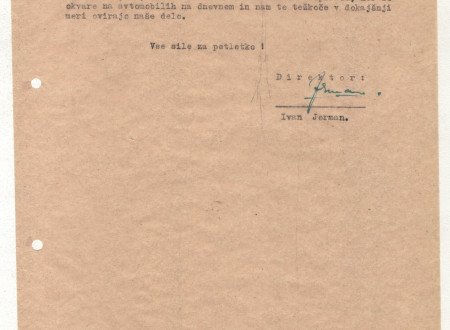Our Land is in the Heart of Europe
Reports on the Shooting of the Film "In the Heart of Europe/On Our Own Land"
One of the main tasks of every film company active in any of the former Yugoslav republics was to make a feature film. Call for tenders for the first Slovenian feature film was the first solo action carried out by the newly founded Slovenian film company Triglav film. Published in Slovenian newspapers on September 17, 1946, the call for tenders met with angry response from the federal committee for cinematography in Belgrade, which had not given consent for its publishing. Soon after that, news appeared in the papers that preparations for the shooting were in full swing and that work would commence in May the following year. In the meantime there was serious work to be done on the writing of the script.
The script was based upon a chosen short story by Ciril Kosmač titled Očka Orel. Kosmač himself wrote the script, which went on to undergo several versions and modifications in which Kosmač did not partake and he was also not satisfied with the final version. On June 15, 1947, the script with the working title In the Heart of Europe was submitted to production team. Of course, there were complications even prior to that, when putting together a production team. At first Bojan Stupica was chosen to direct, but he resigned from the project due to his moving to Belgrade. The new director became Ferdo Delak, who many believed got the job because of his 1932 silent feature film Triglavske strmine. The rest of the members of the production team were Jože Žnidaršič-List as assistant director, France Štiglic as first assistant, Anton Harry Smeh as director of photography, and Viktor Pogačnik as his assistant. Executive producer was Ivan Jerman, who was replaced by Jože Gale just before the end of the shooting on August 21, 1948.
On September 9, 1947, the first day of shooting, the crew left Sv. Lucija ob Soči (present day Most na Soči) for Grahovo ob Bači. The reports on shooting were written from this day forward for every day of the shooting until work on the film was completed on November 6, 1948, regardless of changes that occurred during the process. Ferdo Delak was replaced as the director already on October 30, 1947, when Jože Žnidaršič-List took over for a month. At the beginning of December 1947, France Štiglic became the director and remained so until the end of filming. Almost at the same time, director of photography and his assistant were replaced as well. Their places were taken by Ivan Marinček and Rudi Vavpotič; the latter left the team just before the end of the shooting. By then, around 5000 metres of picture film negative had been shot, which is now nowhere to be found. This was also a turning point within the core of the production team, when younger generation of filmmakers like Štiglic and Marinček replaced the “older” generation of Delak, List and Smeh.
The first report is dated September 9, 1947, and the last one November 6, 1948. Reports were made daily for each separate day until the film was completed. All reports have the same title “Reports on Shooting In the Heart of Europe” except for those written between October 9-28, 1948 which are titled “Reports on Shooting On Our Own Land”. They are a rich source of information on scenes that were shot, technical means applied, actors, shooting locations, etc. and provide an insight into the process of making the film from different perspectives. Usually written by the executive producer Ivan Jerman, the reports were also signed by director of photography, director, and head of shooting.
Let us take a look at some examples. In December of 1947, several days of shooting were to take place in Lanišče pri Škofljici and in film studios in Trnovo. In Januay of 1948, the crew had to shoot in hard winter conditions in Planica and Rateče. The film crew collaborated and also had some issues with the army and pyro technicians. The main reason for cancelling filming was bad weather; weather, in particular waiting for the right light, in general caused many delays in film schedule. Filming was also often delayed because of the actors, who due to various reasons did not manage to come to the set on time; namely, many of them performed in theatres across Slovenia and were unable to come on time due to poor traffic connections. Technical equipment often broke down and it took a long time to get the needed spare parts. Electricity cuts were also frequent occurrence. Efficiency of vehicles was a chapter unto itself. There was a constant need for transportation, but a shortage of vehicles, which often broke down and caused delays in filming. Delays were also often caused by people, whose actions, whether intentional or unintentional, led to interruption or repetition of filming. Problems and obstacles that the crew was dealing with were also described in other reports that were written by Ivan Jerman and addressed to Triglav film management, whose reaction to the crew’s problems seems slow and inefficient. The situation was tense up until the end, when the sound engineer Rudi Omota, while checking the sound copy of the film that had been made in the film laboratory “Avala film” in Belgrade, established that the copy was of poor quality and thus cannot be used. So, additional effort was needed to make sure that the material was ready for the making of the final copy in Belgrade.
In November 1948, there was a screening of the film for the federal commission, which among others included also Edvard Kardelj, Milovan Djilas, Aleksandar Ranković and other members of the federal committee for cinematography. As Štiglic mentioned in one of his later interviews, Djilas reproached him for glorifying Slovenian partisans, but otherwise raised no objections to screening.
The first public screening of the film was held on November 13, 1948 for delegates and participants of the 2nd congress of the Communist Party of Slovenia in Ljubljana, and the film premiere took place in the Union cinema in Ljubljana on November 21, 1948. By February 1949 it was had been screened in 72 cinemas and was seen by 450,000 people. In 1949, it was also screened at the Cannes film festival.
Tatjana Rezec Stibilj





